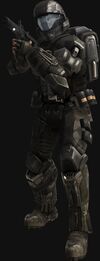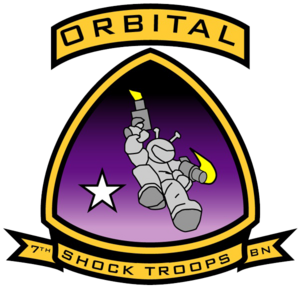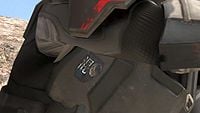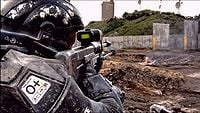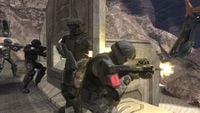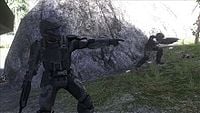Orbital Drop Shock Troopers
From Halopedia, the Halo wiki
Template:Ratings Template:Infobox Military Unit
- "We go feet first, sir!"
- — Shock Troops to Major Antonio Silva, onboard the UNSC Pillar of Autumn.
The Orbital Drop Shock Troopers (ODSTs) are an elite group of UNSC Marines that are specialized in special warfare tactics. Their method of infiltration by orbital drop allows them to conduct missions against targets that more conventional forces cannot approach undetected.
The ODSTs are one of the primary Special Operations units of the United Nations Space Command, and is under the command of UNSC Naval Special Warfare Command.
Background
The Shock Troopers perform highly specialized, small scale, high-risk operations such as:
- Deep Ground Surveillance (or Long Range Reconnaissance): Patrols in small groups, in uniform, moderately far behind the enemy lines. While DGS units may direct air or artillery strikes against enemy positions, they strive to be unobserved, and have only self-defense, not DA, capability. Groups engaging in surveillance deep behind enemy lines, are commonly known as "Long Range Reconnaissance Patrols" or LRRP's.
- Direct Action: Short-duration strikes and other small-scale offensive actions conducted as a special operation in hostile, denied, or politically sensitive environments and which employ specialized military capabilities to seize, destroy, capture, exploit, recover, or damage designated targets. Direct action differs from conventional offensive actions in the level of physical and political risk, operational techniques, and the degree of discriminate and precise use of force to achieve specific objectives.
- Unconventional Warfare: Military and paramilitary operations, normally of long duration, predominantly conducted by indigenous or surrogate forces who are organized, trained, equipped, supported, and directed in varying degrees by an external source. It includes guerrilla warfare and other direct offensive, low visibility, covert, or clandestine operations, as well as the indirect activities of subversion, sabotage, intelligence gathering, escape and evasion.
- Counter-Terrorism Operations: The response to terrorist threats and/or acts, both real and imputed.
- Counter-Contraband Operations: Missions undertaking the recapturing of smuggled/stolen goods.
- Personnel and Special Equipment Recovery/Capture: The recovery/medical treatment of friendly personnel in combat environments, as well as the capability of capturing high valued individuals and any equipment.
ODSTs are recruited from the Special Operations Groups of all the nations and colonies of the Unified Earth Government. Since the first group of “handpicked volunteers” was activated, these shock troopers have been conducting orbital drops ever since [1].
As such, its entrance requirements serve as a third layer of screening upon two more, where applicants would have theoretically failed to pass. Recruits would, therefore, already have extensive experience in conducting the types of high-risk missions that the Orbital Drop Shock Troopers typically perform, which is only supplemented by the additional training. Companies are usually comprised of six-to-eight Combat Teams, with each containing ten-to-fourteen Operators, each of whom has a specific function, able to excel at specific mission-sets while still retaining the flexibility to deal with any situation. While they are not a part of the UNSC's conventional forces, such as infantryman from the Army or Marines, they do conduct joint operations; and tend to be "force multipliers" - increasing the effectiveness, willingness, and morale of those they fight alongside [2].
Unlike some conventional forces, the Orbital Drop Shock Troopers has absolutely no age or gender bias, on the condition that the candidate meets the physical and mental requirements they are guaranteed the opportunity to train for selection into the unit.
History
Origins
The Orbital Drop Shock Troopers have their roots in the paratroopers of 20th and 21st century fame, who dropped frequently behind enemy lines to capture strategically important targets in anticipation for a larger advance by more conventional and numerous military forces.
Such troops were first used in 1939 by the German Air Force in World War II to overrun the Allied positions in the Netherlands and the legendary Eben Emaelfortress in Belgium. Later, during the Battle of Normandy (Operation Overlord) on June 5th, when two American Airborne Divisions and one British Airborne Brigade landed behind enemy lines in Normandy, France on D-Day and again in Operation Market Garden. They were relatively successful, and played a significant part in the war's eventual conclusion as an Allied victory.
The Shock Troopers also contain traits seen in the Reconnaissance Battalions of the United States Marine Corps during the First and Second Gulf War. During the 2003 invasion of Iraq, the 1st Reconnaissance Battalion served as the United States' shock force on the push to Baghdad, the capital of Iraq. Armed with light weaponry, and fast attack vehicles, they eliminated enemy positions for infantry and armored forces from America, Britain, Australia, Poland, and other Allied nations. In addition to their earlier Marine counterparts, they also seem to have characteristics from various NATO and former-Warsaw Pact Special Operations units, such as the US Navy SEALS, British SAS, and the Russian Spetsnaz.
However, the first true instance of dropping Humans from orbit took place during the Martian Campaign of 2163, where UN Marines were dropped onto Mars in support of UN forces against the Neo-Communist Koslovics [3]. The ODST's seem to have "always been a part of the UNSC." It may be that the participants of the Argyre Planitia campaign were the predecessors to, or early members of, the first ODST units.[4]
Human-Covenant War
ODSTs were known to be operating as early as 2525 [5]. The first and most elite division of ODSTs were the 105th Orbital Drop Shock Trooper Division, nicknamed "Helljumpers", and quickly gained a reputation as a brutal and effective fighting force. They are often referred to as elite and seem to have a class of their own, often coming right after the Elites, Spartans and Brutes.
Barring the personnel of the SPARTAN-II Program, ODSTs are one of the most effective forms of troops available to the UNSC, and the expectations placed on ODST units made them all-volunteer outfits, with some outsiders regarding such volunteers as 'crazy' [6]. By 2552 their strength had swelled to a greater number of divisions in an attempt to fill the demands of the Human-Covenant War.
Some ODSTs actively participated in training the SPARTAN-IIs, but the efficiency of the program was demonstrated when a single adolescent SPARTAN-II killed three ODSTs and left the other one severely wounded during an exercise. These fatalities resulted in ODSTs developing a strong disdain for the SPARTANS, as they were felt to be not even worthy of being called Human. The SPARTANS were very frequently referred to as "freaks" by Major Antonio Silva's opinion, to the dismay of John-117.
Operations
- "It's like a postcard: Dear Sarge, We're kicking ass in outer space, wish you were here. "
- — ODSTs to SgtMaj Johnson, after killing a group of Kig-Yar snipers on Installation 05.
Shock Troopers are known for their unorthodox methods of insertion, including orbital drops onto terrestrial environments.
Similar to their Infantry counterparts, the ODSTs maintain units of varying strength aboard many UNSC vessels and Installations. ODST units were present aboard the UNSC Atlas, the UNSC In Amber Clad, the UNSC Pillar of Autumn, the UNSC Forward Unto Dawn, and Cairo Station [7]
They also drop into areas under heavy fire, or are heavily guarded by enemy troops in order to clear out any enemies and set up LZs for Pelican dropships to land or deploy other UNSC reinforcements. ODSTs are recognized as a key element in setting up landing zones and it is speculated that without them, the Pelicans would not be able to carry out air assaults. An example of such scenarios may be observed when the Battle of Installation 05 began. The Marines of the 7th Battalion of the 105th Division, accompanied by MCPO John-117, cleared a landing zone so that Pelicans could drop off light armored vehicles, and eventually land heavy armor after land forces set the bridge down. Shock Troops were also crucial in the Battle of Installation 00, when the 7th Battalion again aided John-117 in breaking a hole in the Covenant line, thus creating a landing zone for the UNSC Forward Unto Dawn, which allowed a forward base to launch an armored assault. Due to the nature of their missions, the ODSTs are also recognized for the heavy casualties they take. They are tough and highly trained soldiers that make sure they get the job done.
Equipment
Body Suit
- Main article: Body Suit
The ODSTs in addition to using standard infantry equipment use a specialized body suit. It is primarily black, and has urban camouflage patterns on certain armor panels. The pressurization of the suit allows for extra-vehicular operations. It has heating and cooling systems to mask the infra-red signature of the wearer, and it also has an oxygen tank capable of allowing 15 minutes in vacuum. The helmet contains state of the art communications gear, along with a Heads Up Display (HUD), along with thermal and motion detectors.
There are several different variations that ODST's equip, with mission-specific functions and goals. Ranged, Close Quarters and Recon variants exist, each designed to better enable their wearers to operate at different ranges, and for different missions. The Recon armor especially is notable, given that it is a MJOLNIR Powered Armor variant, developed alongside the Scout, though only the helmet is worn.
Human Entry Vehicles
- Main article: Single Occupant Exoatmospheric Insertion Vehicle
The Human Entry Vehicle (HEV) is a tear-drop shaped pod made of Titanium-A, Lead Foil and a ceramic skin. They are known for their risky use, as Marines can die either from the intense heat on re-entry, the extreme G-forces, the force of hitting a terrestrial target, or, the parachute may not open to slow the HEV down. This is the main reason why many consider the Shock Troopers to be "insane".
The HEV also contains stores for weapons and ammunition, a short-range radio, a small amount of food if the Marine is ever dropped off target and a small seating compartment which they use as cover if they need to fight immediately when they hit the ground.
Armed Assault Boats
- Main article: Armed Assault Boats
Armed Assault Boats were aircraft used by the UNSC Navy and Marine Corps, to deploy troopers for air assaults. However, the armed assault boats proved to be ineffective, taking heavy fire once within ground firing range and they were also very slow.
The UNSC had later ultimately replaced them with the HEVs [8].
Notable Actions
After the Battle of Reach in August 2552, UNSC Pillar of Autumn made a blind jump away from the Epsilon Eridani system, discovering the long abandoned Installation 04. During the battle on "Alpha Halo", the 22nd Battalion, led by Major Antonio Silva and First Lieutenant Melissa McKay, began to operate as a guerrilla force (as denoted by their role as an "unconventional warfare" unit) by conducting hit-and-run operations against the Covenant soldiers of the Fleet of Particular Justice [9].
Two ODSTs from the 2nd Shock Battalion fought along side a detachment of UNSC Marines in the Battle of Pawas in Winter 2552 [10]. Troopers T. Rymarr and S. Hartley, were tasked with calculating the crash site of John-117 on Earth, while a Marine Battalion was tasked with defending a narrow corridor between Covenant and UNSC forces in Pakistan. Bravo-21 and numerous Marines were killed in the clash, while Bravo-22 was injured along with some of the other surviving Marines. Their actions successfully allowed HIGHCOM to track and locate the SPARTAN.
The Seventh Battalion
- Main article: 7th Shock Battalion
One of the most famed and veteran units of the UNSC Marine Corps, the 7th Shock Battalion served in some of the most climatic and legendary battles during the latter part of the Human-Covenant War. It was a part of the 105th Shock Division, therefore the men and women of the Seventh were referred to as the "Helljumpers". The 7th Battalion fought alongside Master Chief Petty Officer John-117 during most of 2552, and into the end of the war in the Spring of 2553. Men and women from this battalion were also some of the first Humans to travel outside of the Milky Way Galaxy, during the Battle of Installation 00 [11].
Some of the most ferocious fighting done by the 7th battalion was done during the First and Second Battle of Earth. Overall, the defense of Earth was one of the largest campaigns the ODSTs fought in during the 30+ years of the war.
Marines of the Seventh would conduct air assault operations during the opening phases of the ground war at Mombasa, where the troopers battled in the streets before reinforcements from the UNSC In Amber Clad could arrive [12] [13] [14]. Later, additional forces from the UNSC Say My Name would arrive in HEV's to reinforce UNSC positions against the Prophet of Regret's expeditionary force [15]. Most, if not all of the bulk of the reinforcements were killed when the Assault Carrier above New Mombasa, Kenya entered slipspace [16]. Though some Marine Shock Troops were able to survive the slipspace rift, and engage hostile Covenant forces.
Members from an unknown company of First Platoon would later drop from the In Amber Clad onto Installation 05 during the operation to capture the Prophet of Regret. They then cleared a landing zone so that a Warthog could be deployed for John-117. Most of these troopers would perish during the initial campaign against the Covenant, and only a few would escape back to Earth with Commander Keyes [17].
During the Battle of Cleveland in Winter 2552, a squadron of AV-14 Hornets provided a platform for Shock Troops to rescue civilians held inside of a stadium. They fastroped from the Hornets, and dispatched the enemy forces within the stadium in seconds. Minutes later, infantry forces helped the Shock troops eliminate ground forces occupying land in the older part of town.
The 7th Battalion fought during the last battle of the Human-Covenant War, and arguably, one of the largest. Unlike their previous excursions unto the Halo rings, the men and women of the 7th battalion would be exclusively used for air assaults. One such assault happened during a mission to destroy numerous Anti-Aircraft Artillery platforms overlooking a desert sea. These AAA guns were later destroyed by the shock troops, and allowed the UNSC Forward Unto Dawn to successfully land near the cartographer building [18]. During the last battle of the Ark Campaign, and the last of the war, Shock troops were again airlifted into combat. This time, they punched holes in Covenant armored and artillery positions [19]. They assisted MCPO John-117 and SgtMaj Johnson in shutting down the shield generator stations, protecting the Citadel; during which, the Sangheili carrier Shadow of Intent provided air cover, and distracted enemy forces from the joint Human-Sangheili offensive, by firing on the shield with their plasma torpedoes. After their primary objective was complete, allied forces then proceeded to enter the citadel canyon with an armored push on the ground, consisting of Human and Sangheili infantry forces, Warthogs, and M808B Scorpions, covered by AV-14 Hornets in the air.
List of known ODSTs
The status of each trooper is in accordance with their last known appearance. Template:Scroll box
Known ODST Units
- 2nd Orbital Drop Shock Trooper Battalion
- 22nd Tactical Battalion
- 105th Shock Division
- 105th Drop Jet Platoon
- 7th Battalion
- First Platoon
- 7th Battalion
- 340th Orbital Drop Shock Trooper Combat Training Unit
- Alpha Team
- Unnamed Shock Trooper Squad
Trivia
- In Halo: Uprising, when the ODSTs drop off the Hornets, they use a sort of cable they keep inside their belt, much like modern day armed forces off of a helicopter.
- On the right side of an ODST's body armor is a Chinese character which, when translated, means roughly "Complete Bad Ass", a reference to the ODSTs hardcore attitude. Next to the character is the marathon symbol. Putting these symbols together spells the Chinese word "混蛋", also meaning "Badass" or "Bastard".
- ODSTs can also be deployed in Long Range HEVs or "Para-sails" from long distances away from the planet, these can also be under stealth cover.
- Onboard the UNSC Carrier Atlas, John-117 had a confrontational moment with four troopers in the ship's gym. John had removed a pin from the weights at the bench press, and forgot to put it back. The ODSTs walked into the gym and went straight to the bench press. The weights fell and almost crushed one of the soldiers' foot. A fight ensued and John killed three of the ODSTs and severely injured the other. Ever since then, relations between the Spartans and the ODSTs have been tensed and uneasy [20] [21]. This does not seem to stop them from working to their utmost efficiency during the Battle of Installation 00 [22].
- ODST's make their first visual appearance in Halo: Combat Evolved, but are first mentioned in the book Halo: The Fall of Reach.
- The ODST helmet can be used as your character in Halo 3 multiplayer if the player unlocks the Spartan Graduate achievement.
- Halo 3: ODST, a prologue to the story of Halo 3, will feature a six-man ODST squad as the main characters of the game. ODST is based around The Rookie, an inexperienced Lance Corporal, who is tasked with figuring out the whereabouts of his squadmates.
- The Shock Troopers have been confirmed as a playable unit in the upcoming video game, Halo Wars [23]. They will likely be an upgrade to the standard Marine Infantryman and may be able to be dropped behind enemy lines.
Gallery
- Mobassa ODST.jpg
An ODST fire team in the streets.
An ODST faces an enraged Jiralhanae.
Shock Troopers descending in their Human Entry Vehicles over Installation 05.
- 1204677264 ODST Sniper.jpg
An ODST sharpshooter on Installation 00.
- Odstsinpelican.jpg
A squad of ODSTs in a dropship.
- IMGP0850.JPG
ODST concept art from The Art of Halo 3.
Appearances
Related Pages
Internal Articles
External Articles
Sources
- ^ Bungie Weekly Update - 11/21/2008
- ^ Bungie Weekly Update - 11/21/2008
- ^ Pre-Halo: Combat Evolved Storyline
- ^ http://halostory.bungie.org/oconnor_mclees_080508.html
- ^ Halo: The Fall of Reach
- ^ Halo: The Flood, page 35
- ^ Halo 2, Four K.I.A. troopers can be seen in the Cairo Station
- ^ Halo: The Flood
- ^ Halo: The Flood
- ^ Halo: Combat Part Two
- ^ Halo 3, level The Ark
- ^ Halo 2, level Outskirts
- ^ Halo 2, level Metropolis
- ^ Halo 2: Another Day at the Beach
- ^ Halo 3: Recon, Announcement Trailer
- ^ Halo 2, level Metropolis
- ^ Halo 2, level The Great Journey
- ^ Halo 3, level The Ark
- ^ Halo 3, level The Covenant
- ^ Halo: The Fall of Reach
- ^ Halo: The Flood
- ^ Halo 3, level The Ark
- ^ Official Xbox Magazine: December 2008
